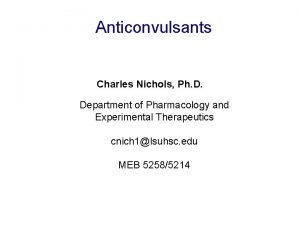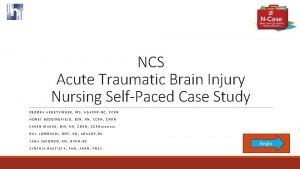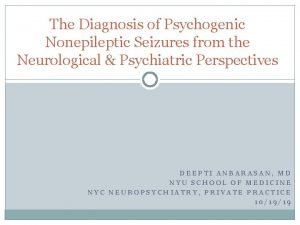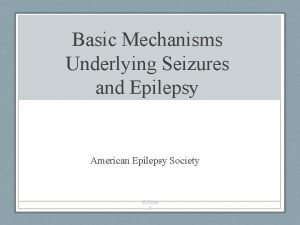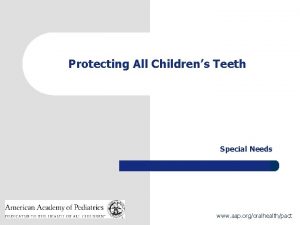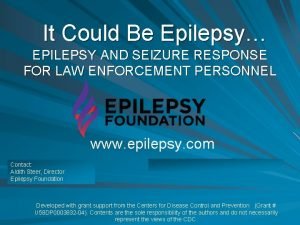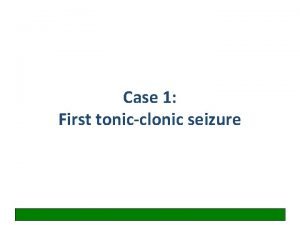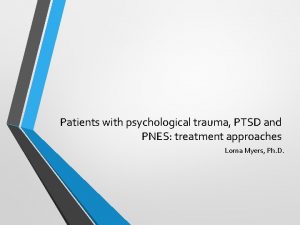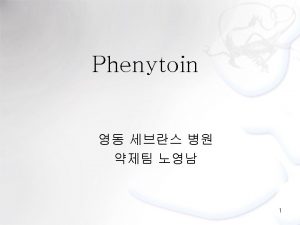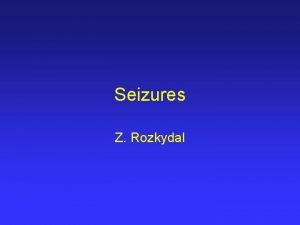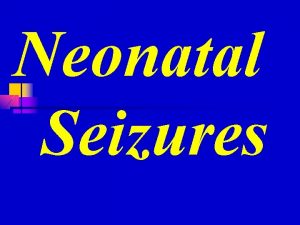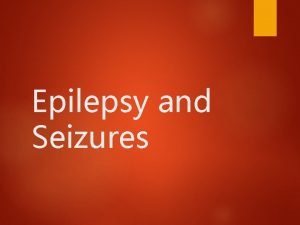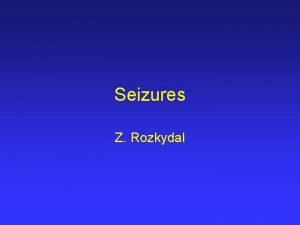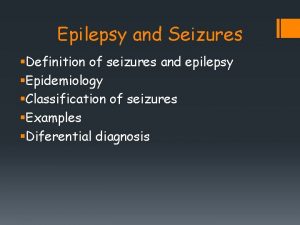SEIZURES IN CHILDHOOD A seizure is a transient














- Slides: 14

SEIZURES IN CHILDHOOD A seizure: is a transient occurrence of signs and/or symptoms resulting from abnormal excessive or synchronous neuronal activity in the brain. The clinical diagnosis of epilepsy usually requires the occurrence of at least 1 unprovoked epileptic seizure with either a second such seizure or enough EEG and clinical information to convincingly demonstrate an enduring predisposition to develop recurrences

In focal (formerly known as partial) seizures, the first clinical and electroencephalographic (EEG) changes suggest initial activation of a system of neurons limited to part of 1 cerebral hemisphere. The term simple partial seizures is a classification that refers to focal seizures with no alteration in consciousness whereas complex partial seizures, currently also referred to as focal dyscognitive, with altered awareness of the surroundings. In generalized seizures, the first clinical and EEG changes indicate synchronous involvement of both hemispheres

Types of Epileptic Seizures Focal Seizures : -Focal sensory seizures -Focal motor seizures Generalized Seizures : -Tonic-clonic seizures - Clonic seizures - Typical absence seizures - Tonic seizures - Myoclonic seizures - Atonic seizures

Status Epilepticus It is defined as continuous seizure activity or recurrent seizure activity without regaining of consciousness lasting for more than 5 min

• FEBRILE SEIZURES Febrile seizures are seizures that occur between the age of 6 and 60 mo with a temperature of 38°C (100. 4°F) or higher, that are not the result of central nervous system infection or any metabolic imbalance, and that occur in the absence of a history of prior afebrile seizures. Incidence 2 -5%

• simple febrile seizure: is a primary generalized, usually tonic–clonic, attack associated with fever, lasting for a maximum of 15 min, and not recurrent within a 24 -hr period. A complex febrile seizure: is more prolonged (>15 min), is focal, and/or reoccurs within 24 hr. • Most patients with simple febrile seizures have a very short postictal state and usually return to their baseline normal behavior and consciousness within minutes of the seizure

• Febrile seizures recur in approximately 30% of those experiencing a first episode Risk Factors for Recurrence of Febrile Seizures MAJOR: • Age <1 yr • Duration of fever <24 hr • Fever 38 -39°C (100. 4 -102. 2°F) MINOR: • Family history of febrile seizures • Family history of epilepsy • Complex febrile seizure

Risk Factors for Occurrence of Subsequent Epilepsy After a Febrile Seizure -Simple febrile seizure 1% -Recurrent febrile seizures 4% - Complex febrile seizures (more than 15 min duration or recurrent within 24 hr) 6% - Fever <1 hr before febrile seizure 11% - Family history of epilepsy 18% - Focal Complex febrile seizures 29% - Neurodevelopmental abnormalities 33%

EVALUATION -Each child who presents with a febrile seizure requires a detailed history and a thorough general and neurologic examination & inv. CBP, RBS, electrolytes… -Determine risk factor of recurrence of the febrile seizures -Manag. Of underlying illness. Antipyretic can reduce discomfort but not reduce the risk of recurrent. - Determine risk factors for later epilepsy If low risk: No therapy or investigations are necessary If high risk: 1. Consider EEG and imaging 2. Consider intermittent oral diazepam or, in exceptional cases that recur, continuous therapy

Lumbar Puncture Meningitis should be considered in the differential diagnosis, and lumbar puncture should be performed for all infants younger than 6 mo of age who present with fever and seizure, or if the child is ill appearing or at any age if there are clinical signs or symptoms of concern.

Electroencephalogram If the child is presenting with the first simple febrile seizure and is otherwise neurologically healthy, an EEG need not normally be performed as part of the evaluation An EEG should, therefore, generally be restricted to special cases in which epilepsy is highly suspected, and, generally, it should be used to delineate the type of epilepsy rather than to predict its occurrence Neuroimaging A CT or MRI is not recommended in evaluating the child after a first simple febrile seizure, EEG and neuroimaging used particularly if the child is neurologically abnormal

TREATMENT In general, antiepileptic therapy, continuous or intermittent, is not recommended for children with 1 or more simple febrile seizures. Parents should be counseled about the relative risks of recurrence of febrile seizures and ocurrence of epilepsy, educated on how to handle a seizure acutely, and given emotional support. If the seizure lasts for longer than 5 min, acute treatment with diazepam (0. 3 -0. 5 mg/kg), lorazepam (0. 1 mg/kg), or midazolam is needed. Rectal diazepam(0. 5 mg/kg) is often prescribed to be given at the time of reoccurrence of a febrile seizure lasting longer than 5 min. Intravenous benzodiazepines, phenobarbital, phenytoin, or valproate may be needed in the case of febrile status epilepticus

If the parents are very anxious concerning their child’s seizures, intermittent oral diazepam (0. 33 mg/kg every 8 hr during fever) or intermittent rectal diazepam (0. 5 mg/kg administered as a rectal suppository every 8 hr), can be given during febrile illnesses. Such therapies help reduce, but do not eliminate, the risks of recurrence of febrile seizures.

Otherapies have included continuous phenobarbital (4 -5 mg/kg/day in 1 or 2 divided doses), and continuous valproate (20 -30 mg/kg/day in 2 or 3 divided doses). In the vast majority of cases, it is not justified to use continuous therapy owing to the risk of side effects and lack of demonstrated long-term benefits, even if the recurrence rate of febrile seizures is expected to be decreased by these drugs.
 Early middle childhood
Early middle childhood Zomisamide
Zomisamide Tremors vs seizures
Tremors vs seizures Hemorrhagic irregular tissue fragments
Hemorrhagic irregular tissue fragments Psychogenic seizures
Psychogenic seizures Simple partial seizures vs complex
Simple partial seizures vs complex Seizure vs epilepsy
Seizure vs epilepsy Basic mechanisms underlying seizures and epilepsy
Basic mechanisms underlying seizures and epilepsy Spina bifida occulta
Spina bifida occulta Pediatric seizures
Pediatric seizures What is a seizure
What is a seizure Seizure
Seizure Psychomotor seizures
Psychomotor seizures Seizures
Seizures Ptsd seizures
Ptsd seizures

